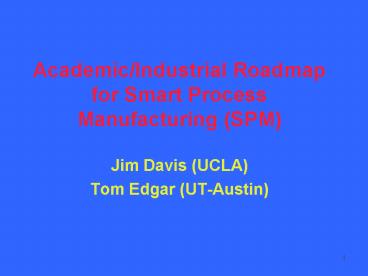AcademicIndustrial Roadmap for Smart Process Manufacturing SPM - PowerPoint PPT Presentation
1 / 19
Title:
AcademicIndustrial Roadmap for Smart Process Manufacturing SPM
Description:
Articulation of the value of smart, 0-incident, 0-emission manufacturing ... RTO, scheduling) with methods to validate model accuracy and its limitations ... – PowerPoint PPT presentation
Number of Views:114
Avg rating:3.0/5.0
Title: AcademicIndustrial Roadmap for Smart Process Manufacturing SPM
1
- Academic/Industrial Roadmap for Smart Process
Manufacturing (SPM) - Jim Davis (UCLA)
- Tom Edgar (UT-Austin)
2
Outline of this Presentation
Background Objectives NSF Workshop
(2008) Key Issues and Obstacles/Solutions Next
Steps
3
What is SPM?
SPM is the enterprise-wide application of
advanced technologies, tools, and systems,
coupled with knowledge-enabled personnel, to
plan, design, build, operate, maintain, and
manage manufacturing facilities. The SPM
enterprise ensures safe and health-conscious
operations with full recognition of people as the
most important resource for success.
4
What is SPM?
- Able to apply learning processes to determine
optimal responses and implement them (e.g.,
adaptive, predictive, proactive), adapting to new
or abnormal situations by evaluating present
circumstances and applying captured knowledge. - Proactive, incorporating real-time data sensing
to eliminate failure before it happens. - Assets are integrated and self-aware (via
sensors) of their state. Assets include plants,
equipment, processes, knowledge, models, and data
properties.
5
SPM and the PSE Community
- Four Key Premises
- Highly trained personnel are critical
- Seize opportunities to optimize operational and
financial performance - Prevent environmental, health, safety, security
problems - Work for the global enterprise
- New Ways of Doing Business
- Decisions based on profitability not expediency
- Opportunities for future profitability
- Faster time to profits
- Smaller time constants for operations
- EH S performance
6
NSF Engineering Virtual Organization (EVO)
Deliverables (24 months)
- An industry/academic/government steering and
oversight team - An organized PSE community and CI supported
processes to develop a technology roadmap - Sustainability modeling following FIATECH
processes - Articulation of the value of smart, 0-incident,
0-emission manufacturing - An initial phase 0 roadmap produced by
industry/academic working group - A workshop and interactive gateway to promote
broad participation and produce a phase 1 roadmap - A mediated living roadmap that is updated
continuously through community involvement - Increased critical mass of an involved and
aligned industry-academic community - Creation of a CI tools clearinghouse
7
Roadmap ElementsAcademic/Industrial Focus
I Industry Technological Development
A Innovation Transformative Academic
Industry
Academia
8
April 21-22 NSF Roadmap Development Workshop
8
11/27/2009
9
SPM Themes
- Simulation
- Multi-scale modeling
- Optimization
- Design (and sustainability)
- Dynamics and control
- Fault detection and
- monitoring
- Sensing and interfaces
- Data aggregation and management
- Network technology
- ESL perspectives
- Supply chain management
- Energy and process integration
10
- Workshop Approach
- Current State Assessment where do we stand
now? - Define the Vision
- Identify Key Issues and Obstacles
- Propose and Rank Solutions
- Develop a Roadmap
11
Phase 0 Roadmap
12
Situation Management
- Issue
- Lack of intuitive technology-based tools to
prevent situations and prepare the plant (people
and assets) for proper response - Solution
- Provide technology (models, sensors, wireless,
network architecture, security) that enables
assets to self-diagnose, publish state,
self-heal, or initiate a proper safe response
13
Plant Operations
- Issue
- Models of processes and operations grow with
advancement in demand and capability, leading to
computational limitations (hardware, algorithms,
model formulation) - Solution
- Develop algorithms for large-scale hybrid
(discrete and continuous) optimization, in
particular take advantage of parallel
computation/multi-core processors
14
Situation/Asset Management
- Issue
- The loss of process operations knowledge/skills
works against the ability to diagnose and
respond the lack of a systematic approach to
capture the experience and knowledge of the
workforce in a usable form - Solution
- Provide a knowledge management solution that
allows operators, engineers, - all stakeholders
to collaboratively enrich the knowledge base and
extract value from the collective knowledge set
15
Control Technology
- Issue
- Require methods and algorithms that allow plants
to take - corrective actions to abnormal situations using
more - detailed process models and appropriate level of
- measurements
- Solutions
- 1. Develop methods for the design of control
systems using wireless sensors and actuators - 2. Develop methods for fault detection and
isolation, accounting explicitly for controller
design as well as fault-tolerant control - 3. Develop associated actuator and sensor
instrumentation networks to accomplish the
fault-tolerant control compatible with other
functions such as quality control, production
accounting, online optimization, etc.
16
Plant Operations
- Issue
- Mathematical models need scope, accuracy, and
consistency to achieve total value - Solution
- Implement a holistic modeling approach leading to
evolution of consistent hierarchical approach for
scope and fidelity for targeted optimization
functions (control, RTO, scheduling) with methods
to validate model accuracy and its limitations
17
Asset Management
- Issue
- The lack of a culture and system for creating,
managing, valuing, and integrating models as
enterprise assets that are maintained just like
physical assets - Solution
- Develop a management and technology structure for
maintaining models as a corporate asset
18
Smart Process Manufacturing Workshop Report
(Draft) From April 21-22, 2008 NSF Roadmap
Development Workshop
To download a copy of this report, visit this
link http//www.oit.ucla.edu/nsf-evo-2008/program
/SPM-Workshop-Report.pdf
19
Next Steps Share Workshop Results And Develop
Roadmap A rich set of issues and solutions was
created during the workshop however there was
insufficient time to develop a complete and
detailed roadmap for each area. Therefore, the
next steps are to communicate the workshop
results and develop a roadmap that lays out
a timeline for delivery of the solutions
an order-of-magnitude estimate of required
financial resources metrics by which to
measure progress































